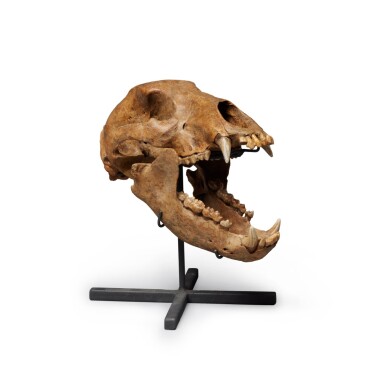Auctions
Buy Now
Collectibles & More
Books & Manuscripts
Natural History
Natural History

Lot Closed
December 3, 07:14 PM GMT
Estimate
5,000 - 8,000 USD
Lot Details
Description
The Skull of a European Cave Bear
Ursus spelaeus
Late Pleistocene (approx. 30,000 years ago)
Drachenhöhle, Mixnitz, Austria
Skull with mandible and full set of teeth, 12¾ by 6½ by 7¾ inches (32.5 x 17 x 20 cm). 11¾ inches tall on custom stand. 6 pounds (2.7 kg).
A robust Ursus spelaeus skull and mandible of a single young adult; both canines and molars show little to no wear. Cheek bones (zygomatic arches) reconstructed. Restoration work to the surface bone (premaxillary) above the four upper incisors. Otherwise, both skull and mandible are intact and close to complete.
From an old European collection, originally discovered in the 1950s.
Austria’s Drachenhöhle Mixnitz (the Dragon's Cave of Mixnitz) has produced the remains of cave lions, alpine ibex, gray wolves, marmots, and this beautiful Ursus spelaeus specimen, a prehistoric bear that lived in Asia and Europe until their extinction around 24,000 years ago.
Similar in size to today’s brown bears, Ursus spelaeus stood nearly 12 feet (3.7 meters) tall and could weigh up to a ton. Like all bears, they lack a last upper molar, with the next-to-last upper molar becoming elongated in order to grind against its last lower molar. As with Ursus spelaeus, these adaptations allow bears to eat a wide variety of foods, including roots, plants, meat, seeds, berries, and insects.
Colloquially known as the “true cave bear of Europe”, this late Pleistocene species lived alongside and may have competed for shelter with Neanderthals and Cro-Magnons (Early European modern humans). Multiple cave art sites have been discovered depicting their likeness, as well as archaeological evidence hinting at Cro-Magnon use of cave bear remains in spiritual and/or ritualistic practices.
This captivating Ursus spelaeus fossil represents a highly desirable specimen suitable for both aesthetic exhibit and scientific research.